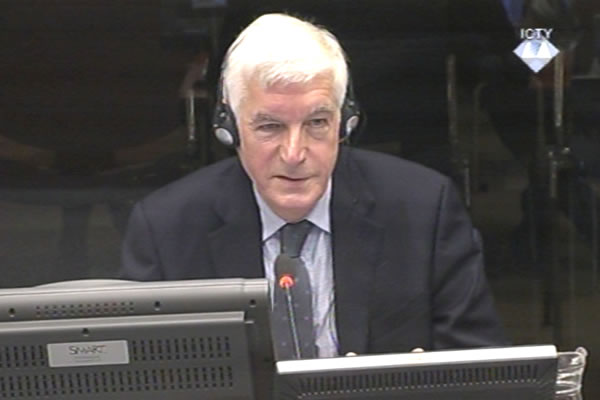Home
FORENSIC EVIDENCE OF SREBRENICA CRIMES
British pathologist John Clark said at the trial of Ratko Mladic that most of Srebrenica victims exhumed by 2001 were men who had been shot to death. Some of the bodies recovered from mass graves were blindfolded and had their hands tied. This corroborated the prosecution’s case that the Muslim men and boys were victims of mass executions
 John Clark, witness at the Ratko Mladic trial
John Clark, witness at the Ratko Mladic trial The trial of Ratko Mladic continued today with the evidence of John Clark, British forensic pathologist. Clark is a medical doctor who, as he explained, specializes in ‘establishing cause of death’. Clark has already testified in seven cases before the Tribunal. Parts of Clark’s testimonies at the trials of General Radislav Krstic and Radovan Karadzic were admitted into evidence today.
The summary of those testimonies was read out in court by prosecutor D’Ascoli. According to the summary, from 1999 to 2001, Dr Clark headed the OTP team that carried out the exhumations at several locations in BH. Dr Clark conducted most of the postmortems of the bodies of the people from Srebrenica killed in July 1995 and buried in mass graves at Kozluk, Konjevic Polje, Nova Kasaba, Glogova, Lazete, Ravnica and Zeleni Jadar. Every year, Dr Clark wrote a summary report on the exhumations of the Srebrenica victims. When Dr Clark confirmed in a brief examination-in-chief the findings from his reports, the reports were admitted into evidence. Having examined the bodies and analyzed thousands of postmortem findings made by the pathologists from his team, Dr Clark was able to conclude that in most of the cases the remains recovered from the graves belonged to men. Most of the victims had been shot to death. Some of the bodies found in the graves in Kozluk and Lazete had blindfolds and their hands were tied.
In addition to the summary reports, some other reports the witness wrote on the basis of the exhumations and postmortems of bodies from other locations in BH, such as Kevljani, Ivan Polje, Jama Lisac etc., were admitted into evidence. Most of the bodies in those graves had sustained gunshot wounds. The only exception was the grave site in Kevljani near Prijedor where most of 73 bodies and 70 body parts revealed signs of blunt trauma.
In his cross-examination, Mladic’s defense counsel Miodrag Stojanovic highlighted the part of the report Clark wrote in 1999, where he inventoried the problems he had encountered in the analysis of the mass graves of Srebrenica victims. Among them was the fact that the pathologists who were part of the team didn’t all speak English well and had different medical and legal background. Today the witness confirmed it, adding that ‘luckily’ he was able to understand the pathologists who didn’t speak English well. Everybody on the team used the same methodology and the same forms and there was not much divergence in the final findings.
In support of his argument that there were different approaches, the defense counsel used two examples of victims with leg injuries. In the first case, Clark concluded that the cause of death was unknown, i.e., that it was not possible to state how the person died. In the other case, a pathologist from Sri Lanka found that the cause of death was the entry-and-exit gunshot wound to the leg. The witness admitted that here similar cases were treated differently, adding that there were no more than one or two percent of such cases.
John Clark completed his evidence today. Mladic’s trial will continue tomorrow with the testimony of new prosecution witness.
Linked Reports
- Case : Mladic
- 2013-09-20 AIR BOMBS WERE WORSE THAN UNRELIABLE
- 2013-09-20 RATKO HAD HEART OF DOVE
- 2013-09-19 KARADZIC’S DIRECTIVE 7 WAS ‘ILLEGAL’, MLADIC’S ‘LEGAL’
- 2013-09-26 RECONSTRUCTION OF SNIPER INCIDENTS IN SARAJEVO
- 2013-09-30 VICTIM FROM FOCA: ‘THEY TOOK AWAY MY HAPPINESS’
- 2013-10-01 CONTESTING SARAJEVO INCIDENTS
